Vacheron Constantin is best known for its high complications packed in beautiful, traditional cases and dials. And while these are at times freshly combined or somewhat reinvented, it is the elegance of these watches that is generally remembered more than a groundbreaking new invention or breathtaking combination of complications.
The Traditionnelle Twin Beat is set to change that perception for this very old brand: not only will connoisseurs be likely to remember the interesting and useful mechanical novelty, they will also be sure to take note of the design departure that showcases the extreme technology of this watch.
Vacheron Constantin Traditionnelle Twin Beat: overview
In a nutshell, the Vacheron Constantin Traditionnelle Twin Beat adapts to the needs of its wearer by maintaining two frequencies that the wearer can choose between: a 5 Hz frequency for precision while the watch is being worn and a 1.2 Hz frequency when the watch is put down.
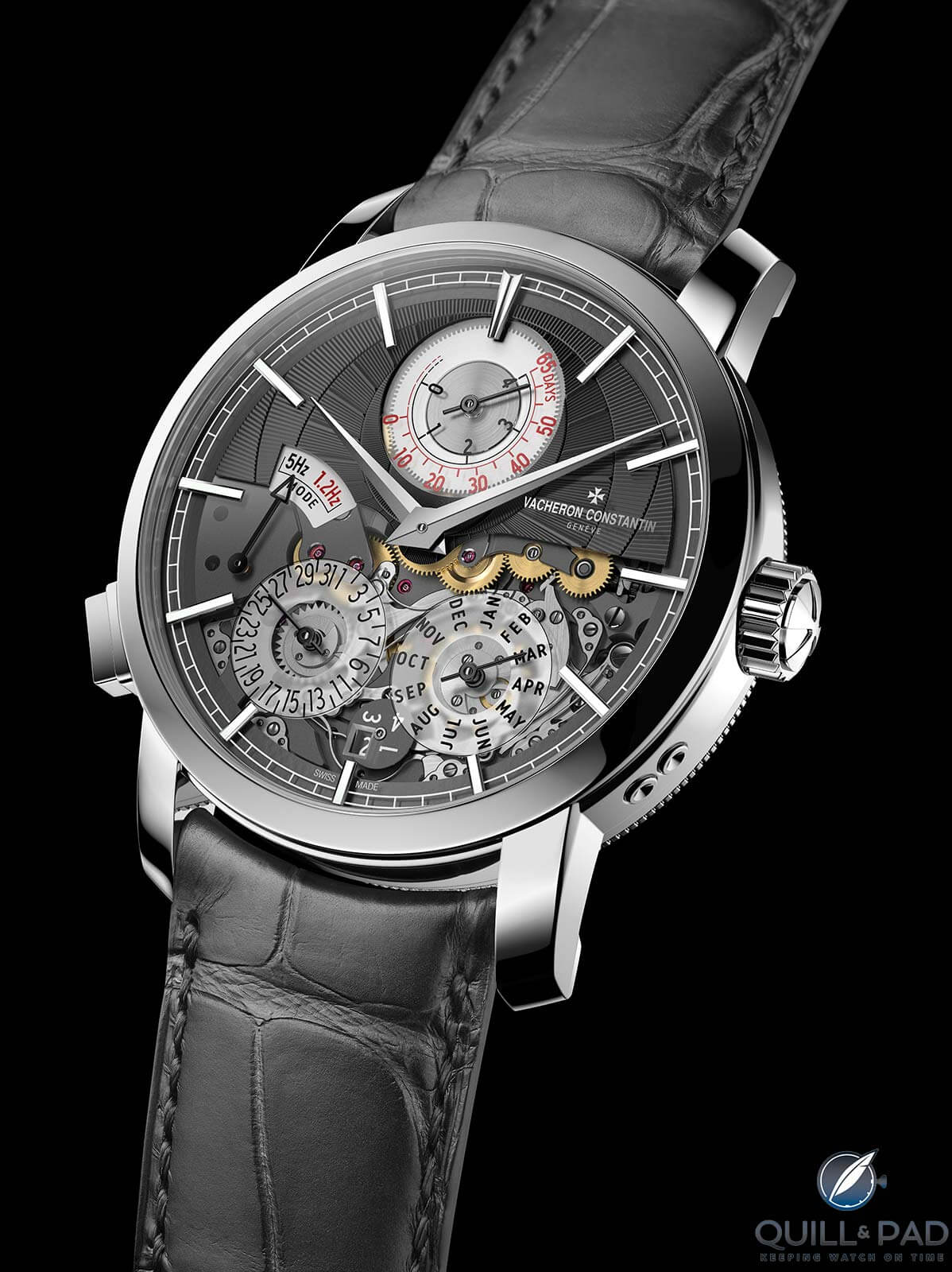
Vacheron Constantin Traditionnelle Twin Beat
The 5 Hz frequency was chosen as the “active” frequency because it allows for more precise timekeeping abilities. As a rule, higher frequency equals higher timekeeping precision.
Until the last decade or so, the one drawback to higher frequency has been the fact that it also equals faster wear and tear to the movement. And herein lies the premise of the Twin Beat: to save the movement from undue wear and tear when the watch is not in use, yet still keep it wound.
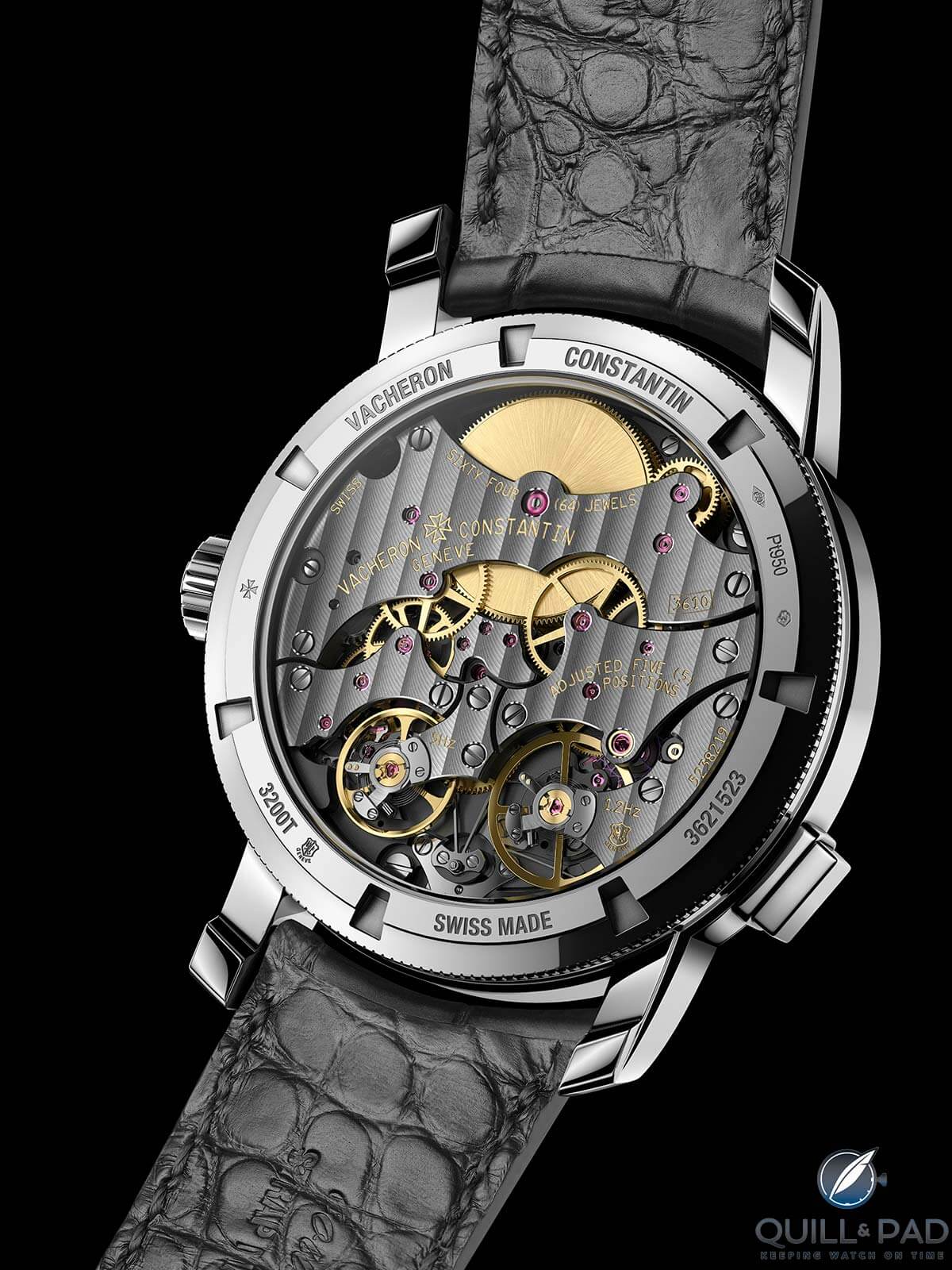
View through the display back to the Vacheron Constantin Caliber 3610QP movement
While other modern 5 Hz watches rely on new materials like silicon and nickel-phosphorus LIGA, the Vacheron Constantin Traditionnelle Twin Beat’s movement includes only traditional materials like brass and steel except in two places: the silicon escape wheel of the 1.2 Hz gear train and one of the twin spring barrels.
But in the other places, it is improved quality and geometry of materials that create less friction, allowing the manufacture’s watchmakers to set the escapements to a higher frequency to gain more precision in the active mode.
By way of comparison: until about the 1950s, wristwatches were mainly set to a frequency of 2.5 Hz; since then frequencies have steadily been rising, with 4 Hz having become the modern norm as a good precision standard that also isn’t awful in terms of wear on the movement parts.
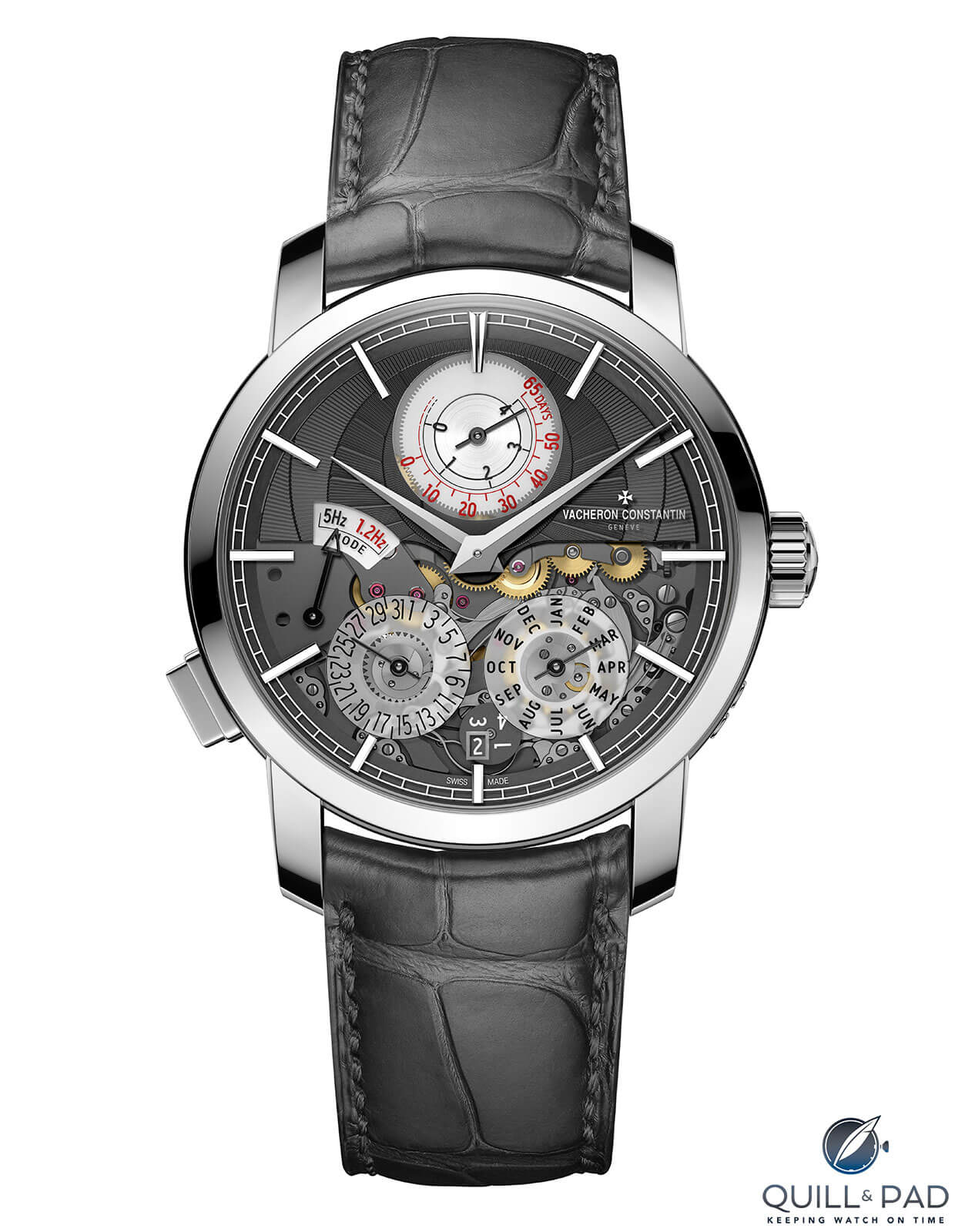
Vacheron Constantin Traditionnelle Twin Beat
When the Traditionnelle Twin Beat is not being worn, the wearer can slow the frequency to 1.2 Hz using a button on the case at 8 o’clock to put it in a standby mode that beats at 1.2 Hz, which has the extreme advantage of extending the watch’s power reserve to a maximum of 65 days. In 5 Hz active mode, the watch also boasts a phenomenal four days’ worth of power reserve.
Which means that the watch can be kept wound for about two months without having to be set or adjusted again.
This also means that the perpetual calendar of this watch most likely comes closest to operating as intended: in perpetuity. At any time during the 65 days beating at 1.2 Hz (8,640 vph), the wearer can switch back to active mode at 5 Hz (36,000 vph) and all the calendar displays will still be correct.
For those not familiar with perpetual calendars, they automatically mechanically keep track of how many days there are in each month, including the 28th and/or 29th day in February (with the exception of the secular leap year, which occurs only very infrequently and makes a leap year into a non-leap year – yay for the Gregorian calendar!).
Vacheron Constantin Traditionnelle Twin Beat: technical details examined
First off, this is Vacheron Constantin’s first watch to beat at a frequency of 5 Hz. According to the brand’s style and heritage director Christian Selmoni, the manufacture created a “speed recorder” in the 1930s that beat at a 10 Hz frequency. But this is the brand’s first serial foray into high frequency.
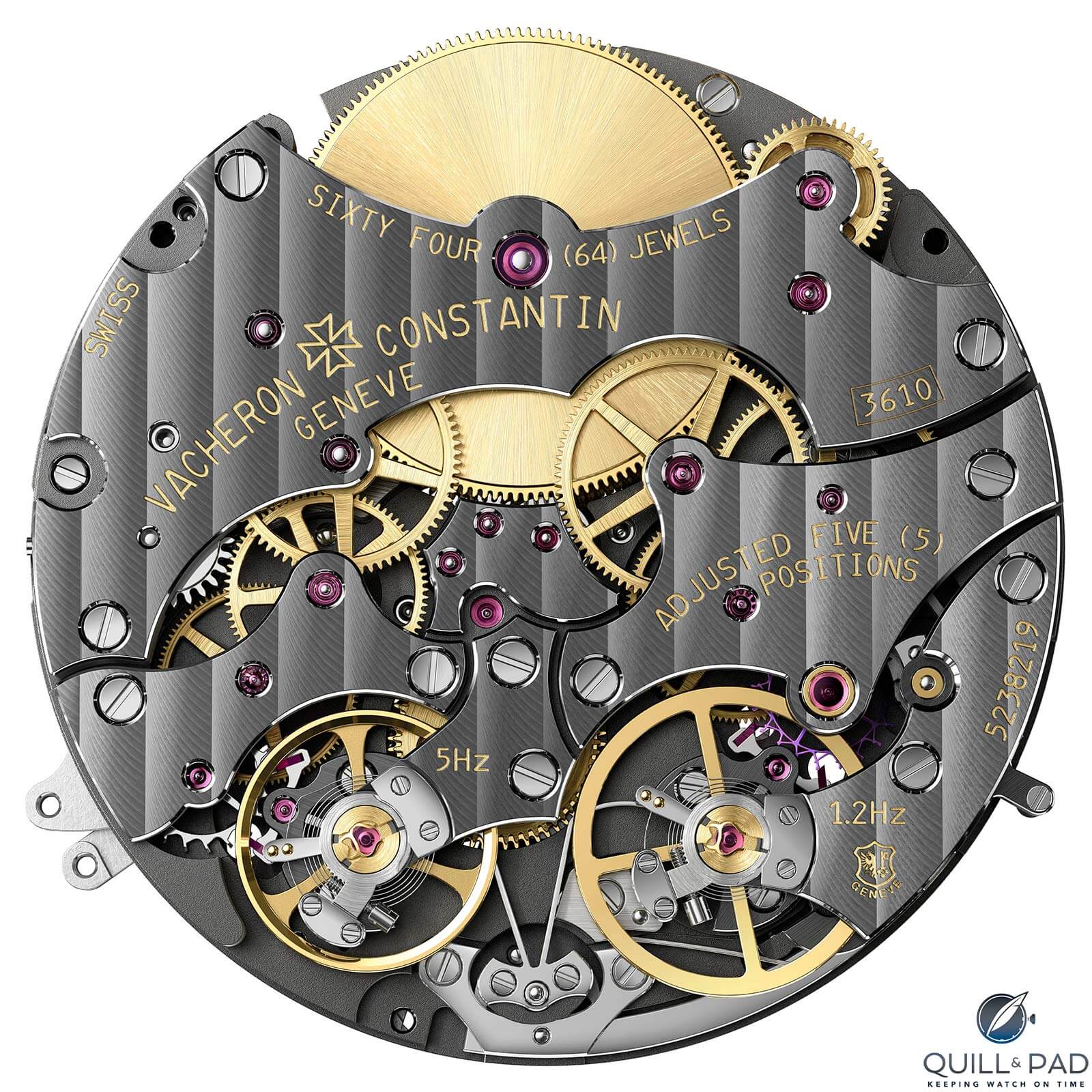
Vacheron Constantin Caliber 3610QP movement side
Caliber 3610QP, which is a 100-percent in-house development, contains two balances, each of which operates at a different frequency. These two components make up the heart of the patent-pending Twin Beat system, which transitions between the two frequencies – one for active mode and the other for standby mode – without interruption of timekeeping accuracy.
The concept was inspired by the Wadokei, a traditional Japanese clock produced during the Edo period that told “seasonal time” by partitioning day and night each into six parts. This time reckoning was of course variable, but it was mastered by using a single or double foliot balance for “automatic” changes needed.
Here the changes in frequency needed for active mode and standby mode are dictated by the wearer and controlled by simply pushing a button on the case. This mode selector operates on an all-or-nothing principle – often seen in repeating movements – which ensures only one balance runs at a time. The all-or-nothing construction also makes sure that the switch between frequencies is instantaneous, which in turn ensures that the timekeeping capacity is not interrupted.
Both balances are driven by the same spring serially operating twin spring barrels (one of which is made of silicon), but separate gear trains.
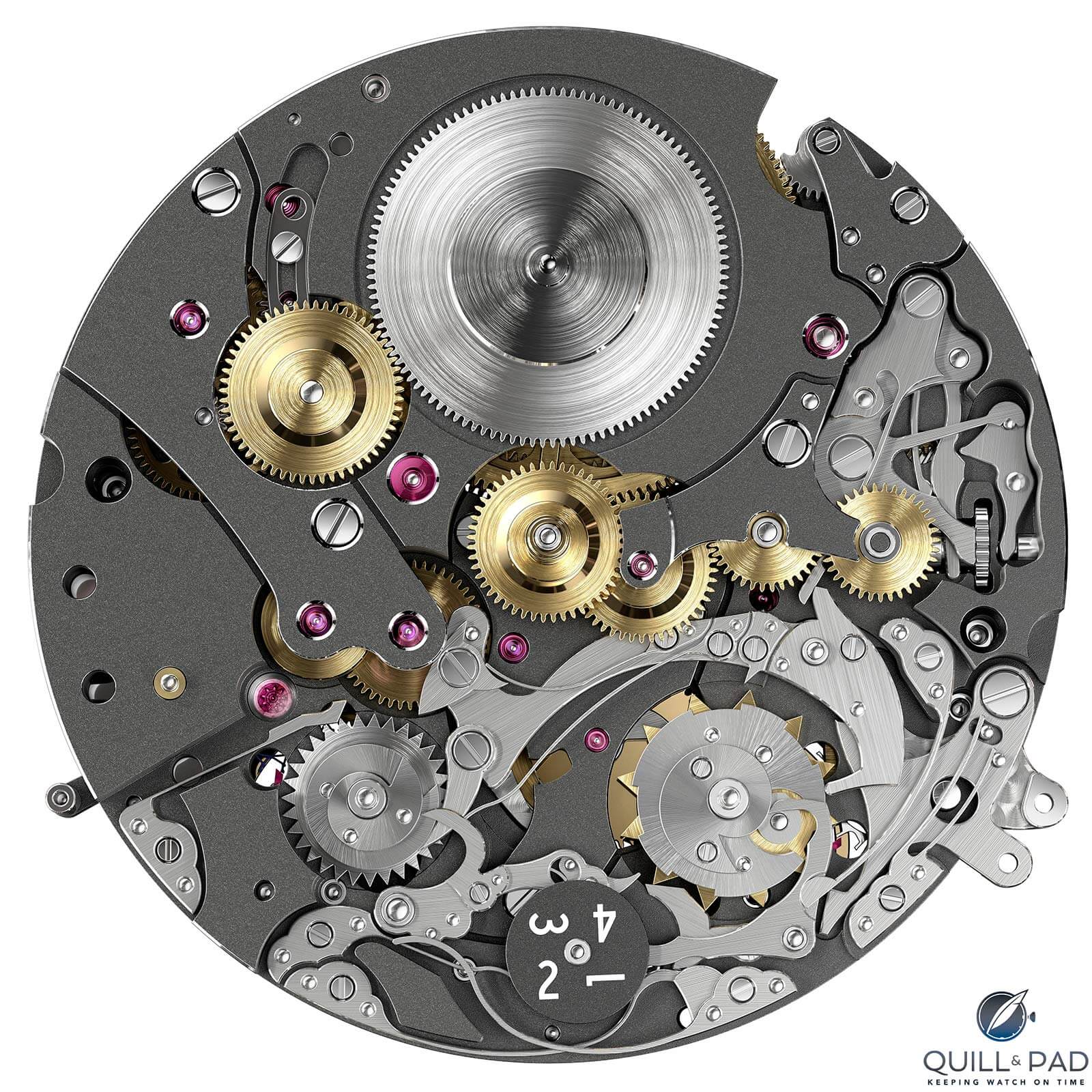
Front of the Vacheron Constantin Caliber 3610QP movement
Vacheron Constantin reworked its perpetual calendar to use as little energy as possible. Mechanisms that include instantaneous jumps, which are notorious for their as energy drain, adversely influence the balance, causing loss of amplitude, which in turn affects chronometry. The more jumping displays – as in a perpetual calendar – the more effect on energy levels and chronometry can be expected.
Therefore, Vacheron Constantin has redesigned the jumping mechanism to include a twin-gear system driven by a spring needing four times less torque than a conventional display.
Vacheron Constantin Traditionnelle Twin Beat: balance springs
Naturally, research and development into these new, unconventional solutions required the very old manufacture to open new avenues of thought within its own halls, which resulted in a rethinking of the hairspring. A new balance spring was therefore created specifically for one of the two balance’s needs.
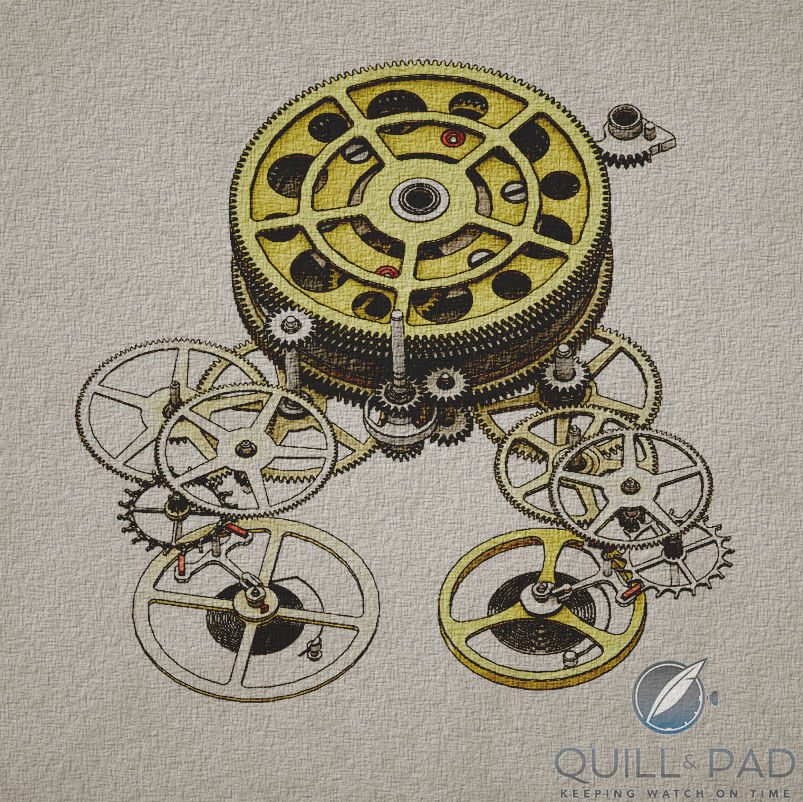
The dual gear trains plus spring barrels of the Vacheron Constantin Traditionnelle Twin Beat
Because of its extreme sensitivity, the “standby” balance beating at 1.2 Hz has received a reconfigured spring conceived especially for this movement comprising a non-standard metal alloy whose cross section is about four times smaller than that of the “active” balance beating at 5 Hz. Its diamter at 15 microns is less than that of a human hair.
Because the hands and displays receive their information from the dual balances (and attached dual gear trains) that switch back and forth, a differential gear was added to smoothly allow the reversals.
A second differential has been added to the spring barrel to achieve its dual goals: winding the mainspring and reducing the torque in standby mode. Two other differentials allow the power reserve indication to receive and display its crucial information.
Despite all of the technology packed into Caliber 3610QP, it remains rather svelte at 32 x 6 mm – not bigger than some regular time-only movements! It contains a total of 480 individual components.
Vacheron Constantin Traditionnelle Twin Beat: style
For all of the technical power located within, this watch comes in at a compact – and extremely wearable – size of 42 mm in diameter and 12.3 mm in height.
And perhaps even more remarkable is its matching contemporary design, which is certainly a departure for this brand usually concentrated on classic looks.
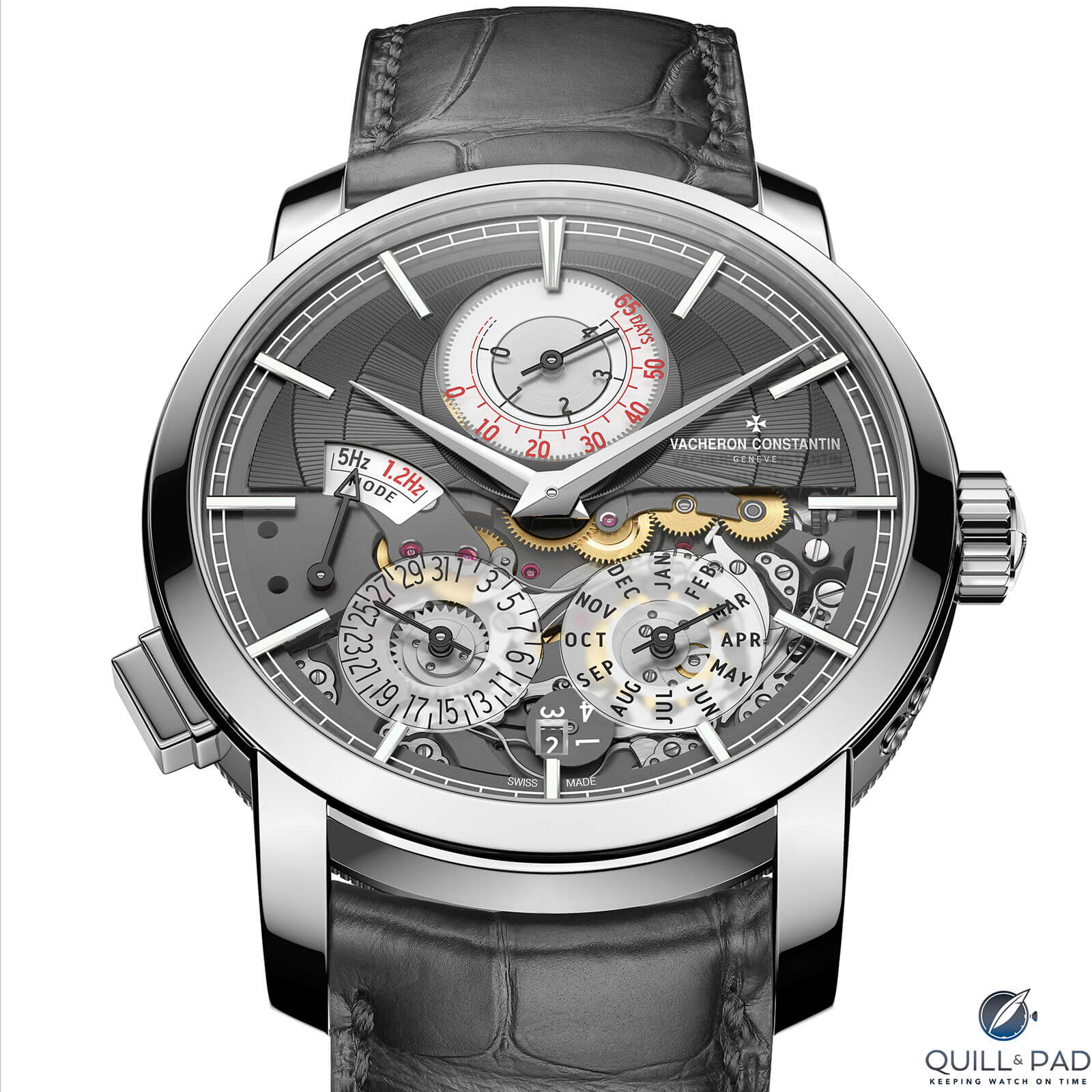
Vacheron Constantin Traditionnelle Twin Beat
However modern the aesthetic may be, though, it does not lack in the all-important finishing techniques that this brand’s clients and admirers love and expect.
While the plates and bridges are coated with darker-colored NAC – giving these components the immediate impression of being more modern and providing them with better readability against the darker background – they are of course also decorated with traditional côtes de Genève. In addition to color, the NAC treatment also provides more resistance to scratching and age than other processes for adding color like PVD.
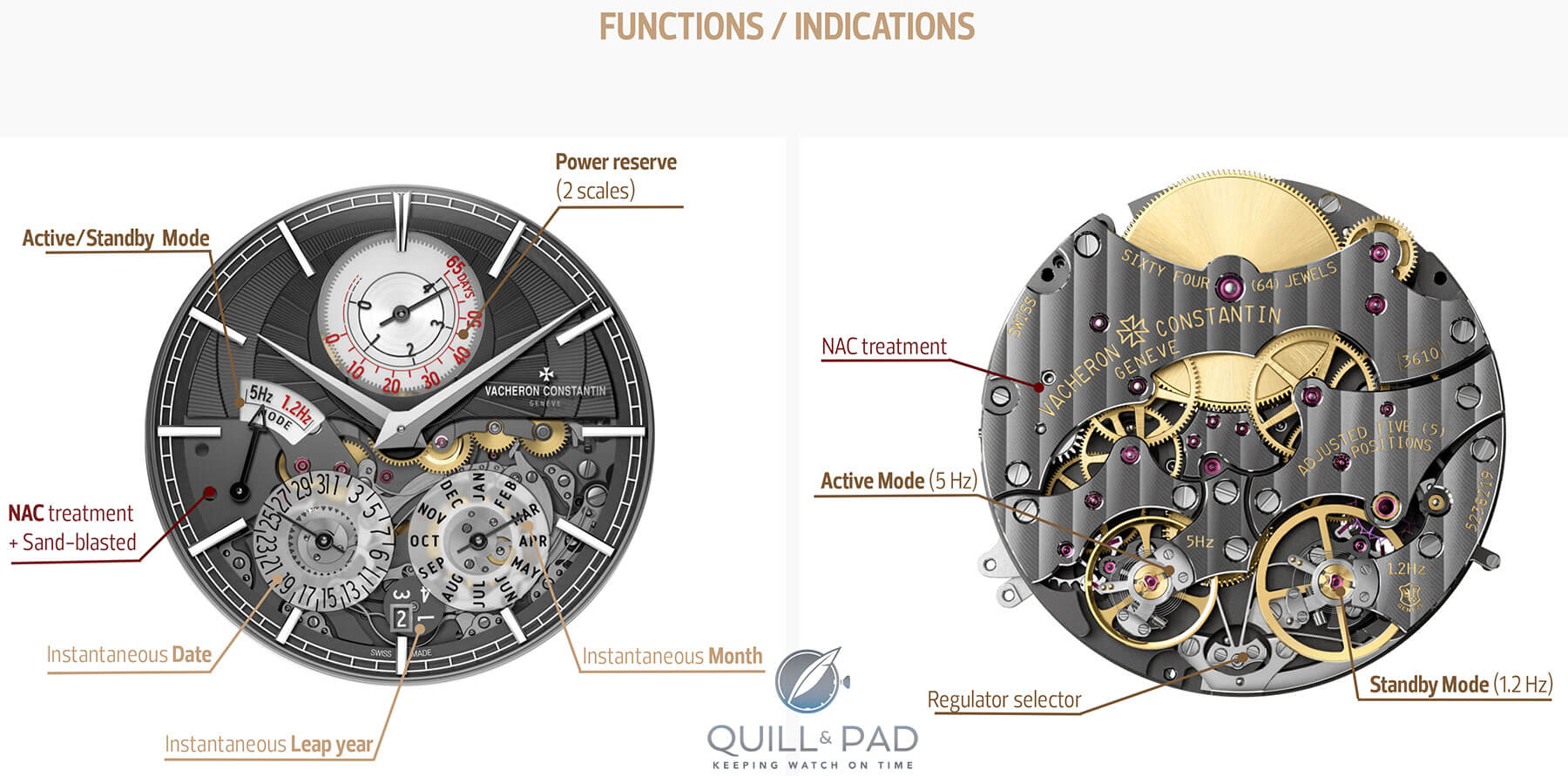
Vacheron Constantin Traditionnelle Twin Beat movement details
And despite the movement’s modern aesthetic, it fully complies with the strict standards of the Geneva Seal, which keep a tight rein on quality, craftsmanship, and reliability for Geneva-based manufacturers.
The dial is equally modern looking. In fact so modern that there is hardly a dial at all; instead the observer is chiefly treated to a view of the movement’s functions punctuated by sandblasted, NAC-treated bridges and unusual dial components that draw the eye to the power reserve display.

Vacheron Constantin Traditionnelle Twin Beat
The power reserve display is given place of pride at 12 o’clock, signifying its importance to the concept of this watch. Other components seen from the front are made of white gold (though you’d never know it by looking at them) and then decorated with a modern style of hand-applied guilloche created especially for this watch. These segments are then fitted to a sapphire crystal dial segment.
White gold hour markers are fitted to the sapphire crystal, which is laser-engraved and then filled with ink to create the railroad track for marking off minutes. Thus, this watch retains its roots in tradition, but puts a foot squarely toward modernity thanks to forward-thinking processes: its technical-looking dial reflects the very technical movement within.
The platinum case and white gold hands are classic Traditionnelle design by Vacheron Constantin, which creates an exciting look when paired with these progressive elements.
This is one perpetual calendar that is like no other, and it offers real efficiency and benefit to its owner.
For more information, please visit www.vacheron-constantin.com/en2/watches/traditionnelle.
Quick Facts Vacheron Constantin Traditionnelle Twin Beat
Case: 42 x 12.3 mm, platinum
Movement: manually wound Caliber 3610QP with user-controlled dual-frequency capability; 5 Hz/1.2 Hz frequency; up to 65-day power reserve at 1.2 Hz and four days at 5 Hz; two balances and gear trains; 480 components, Geneva Seal
Functions: hours, minutes; power reserve indication; date, perpetual calendar with date, month, leap year; frequency mode
Price: €210,000, boutique edition only
You may also enjoy:
How Vacheron Constantin Celebrated Its 250th Anniversary In 2005
Vacheron Constantin’s Reference 57260 Is The Most Complicated Portable Watch In The World
Vacheron Constantin Traditionnelle Minute Repeater Tourbillon: Understated Perfection
Leave a Reply
Want to join the discussion?Feel free to contribute!





















































Thanks, Elizabeth, for your detailed analysis of this very interesting watch. It is amazing how the industry can produce completely new ideas from time to time (although perhaps not as often as claimed!). Best wishes.
Thanks for reading, Tim! This was for me the best watch of SIHH 2019. As you point out, a completely new idea – and one that makes a lot of sense! In other words, not just crazy mechanics for the sake of crazy mechanics, but with a purpose.
As I can no longer get to Fairs Q&P keeps me in touch with what’s going on. You are interested in the same sort of things as I am. Keep up the good work.